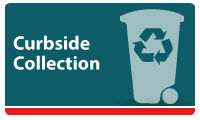Organics Collection
Tote Safety: If you need to reach into your tote for any reason, ensure that the tote will not roll away from you and that the lid is opened fully.

Please ensure your yard waste/organics totes are closed at the time of collection. Totes with flipped back lids and tree branches longer than 24" or greater than 2" in diameter can both damage the bear-proof banding on your tote and disable the truck. Any overfilled totes will be marked indicating "oversized yard waste" and will not be serviced on collection day.
If you have more organic or yard waste than you can fit in your tote, you can stockpile it until you can fit it in your tote at a later date, use a backyard composter, leave grass clippings on the lawn, take it to the Squamish Landfill Public Depot for a small fee, or ask your neighbours if they have any extra space.
Having trouble with maggots? Get tips here.
Why should I use my organics tote?
A 2016 Waste Audit conducted by the District of Squamish revealed that 35% of residential waste from curbside collection was organic, yet it is a reusable resource. Collecting organic material separately from garbage helps to extend the life of the landfill, limits greenhouse gas production from the landfill, and produces a valuable soil amendment.
How does it work?
- Collect food scraps and food soiled paper in your kitchen container. You can line your kitchen container with newspaper or paper bags, or use it on its own. Plastic bags of any type are not permitted - even those that claim they are compostable. Watch this YouTube video demonstrating how to make a liner from newspaper or download these instructions. The "Green Lid" compostable bins are also acceptable.
- Empty your kitchen container into your organics tote and layer with yard waste if possible. Rinse your kitchen catcher regularly.
- Place your unlocked organics totes curbside by 7:45 am on your collection day. Your organics tote will be collected bi-weekly, year round, on the same day as your recycling tote.
What can I put in?

What goes in |
What stays out |
|
| Vegetables and fruit – cooked and raw, including peels, pits and seeds. Corn cobs, corn husks and avocado seeds are okay. | Plastic bags and plastic wrap, even if marked compostable or biodegradable | |
| Meat and bones – cooked or raw | Plastic containers and plastic cutlery, even if marked compostable or biodegradable | |
| Fish and shellfish – cooked or raw | Styrofoam | |
| Dairy products including cheese and yoghurt | Twist ties, rubber bands, stickers and bread tags | |
| Egg shells and eggs | Coffee cups and straws | |
| Bread, baked goods, pasta, cereal, pizza | Any kind of metal or glass including tin foil and pie plates | |
| Flours and grains | Diapers and baby wipes | |
| Nuts and nutshells | Pet waste or kitty litter | |
| Plate scrapings | Lined paper bags e.g. pet food bags | |
| Coffee grounds, filters and tea bags (except “silk” or plastic tea bags) | Cotton balls and dental floss | |
| Small amounts of fats and oils (soak into newspaper or used paper towels) | Cigarettes and cigarette butts | |
| Butter, margarine and lard | Vacuum bags | |
| Used paper towels, facial tissues, paper napkins, paper towel rolls and toilet paper rolls. | ||
| Paper food packaging including cardboard egg cartons, paper plates and pizza boxes. Must not be wax lined. | ||
| Popsicle sticks, small wooden utensils, toothpicks, wood chips and sawdust from untreated and unpainted wood | ||
| Leaves, grass clippings, hedge trimmings, plants, flowers | ||
| Small branches less than 3” in diameter and short enough to fit in the tote with the lid closed. |
Tips for reducing conflict with wildlife and pests
- The organics totes are fitted with a wildlife resistant locking system. In order to be effective, both locks must be locked at all times except the morning of collection day (as per the Wildlife Attractant Bylaw). If possible, keep your tote in a shed or garage. Put your tote out by 7:45 a.m. on the morning of collection day, never the night before.
- Wrapping your food scraps in newspaper or paper bags helps to reduce odours and keep your organics tote and kitchen catcher clean.
- If possible, keep meat, fish and bones in your freezer or fridge until collection day.
- Cover and layer food scraps with yard waste in your organics tote whenever possible.
- Allow grass clippings and leaves to dry before placing them in the tote.
- Sometimes maggots (fly larva) grow in organic material. To reduce this problem make sure that both your kitchen catcher and organics totes are tightly closed at all times so that flies cannot lay eggs in your organic material. If you do see maggots in your tote, they can sometimes be killed by putting salt,vinegar, or lime directly on them.
- Rinse your kitchen catcher and tote regularly. You can use a mild detergent or vinegar/water solution for this purpose.
- If your tote is damaged and/or is not locking, email GFL Environmental for a repair.
What happens to my compost?
Composting is the art of turning food scraps, yard waste and other organic materials into nutrient-rich soil. A healthy combination of heat, oxygen, moisture, naturally-occurring micro-organisms and food scraps will create productive soil and can reduce your garbage production by a third. Watch this short video to learn more about how Squamish's commercial and residential organic material is composted.
